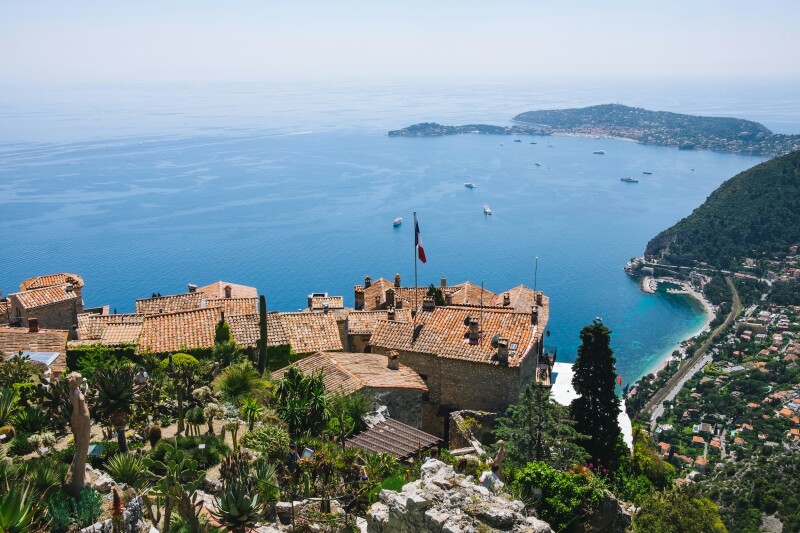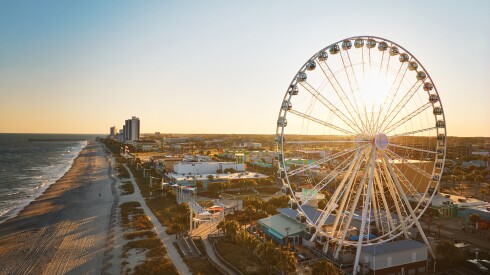Every year, thousands of holidaymakers hear the French Riviera’s siren song and flock to the sunny shores of Antibes, Cannes, and Saint-Tropez. Nice, the region’s capital, is France’s second most visited city, clocking an incredible 5 million visitors each year—shockingly high, considering residents number a little over 340,000. Even the tiny principality of Monaco gets an honorable mention for the fashionable, famous Port Hercule.
But to really get to know the Riviera, you need to leave the big-name cities. Nice may be the region’s beating heart, but these chic villages comprise its quiet, ageless soul. Here’s where southern France really shines.
1. Menton
Menton, simply put, is lovely with its pastel-colored buildings, terra-cotta roofs, and splashes of matching turquoise shutters. It was once a favorite of Queen Victoria, whose visit here in 1882 put it firmly on the map for traveling Brits. Menton draws crowds in the late summer, so the best time to visit is in spring, when it’s quiet.
The town borders Italy, and most menus feature pasta and gelato. The air is always fragrant with citrus, something that Menton is famous for (especially its lemons) thanks to its perpetually sunny skies and temperate climate. Stroll around the old town to find hidden shops, visit the old market for fresh, hyper-local produce, and spend an afternoon on the Plage des Sablettes, where you’ll find the most spectacular view of the old town.
Where to stay
Book now: Hôtel Princess et Richmond
Hôtel Princess et Richmond is located right on the waterfront, and guests have the option to select a sea- or mountain-view room. The Cavarelli family has run the property for four generations, but don’t worry that it’s stuck in the past: It includes plenty of modern amenities, like the seventh-floor solarium terrace, where you can take in the panoramic view, stretching from Italy to Cap-Martin, from the Jacuzzi.

Artists have been attracted to the beautiful medieval village of Saint-Paul-de-Vence for centuries.
Photo by EyesTravelling/Shutterstock
2. Saint-Paul-de-Vence
High in the hills to the west of Nice, Saint-Paul-de-Vence has always attracted celebrities: Churchill once sat down to paint the fountain off the main square; Bill Wyman of Rolling Stones–fame owns a house in the walled city; and silver screen stars like Orson Welles and Michael Caine were frequent visitors. Picasso, Matisse, Modigliani, Miró—this town has seen them all come to take advantage of the famous Mediterranean light. Stop by one of the many galleries before lunch at La Colombe d’Or—the noted hotel where the rich and famous still stay today—then play a few rounds of pétanque with the residents outside Café de la Place.
Where to stay
Book now: Le Saint Paul
Le Saint Paul, in the center of the village, is an exercise in luxury and refinement and a member of Relais & Châteaux for more than 30 years. Its restaurant is well worth booking for dinner, thanks to dishes like foie gras with currant and verbena chutney and roasted local trout.

Follow in the footsteps of Nietzsche and Bono in the village of Èze.
Courtesy of Chelsea Essig/Unsplash
3. Èze
Like Saint-Paul-de-Vence, Èze is another hilltop haven, filled with narrow cobblestone lanes that snake from one end of town to the other. Locals often take a short but challenging hike via le chemin de Nietzsche (Nietzsche’s path), which the philosopher was rumored to walk in search of inspiration. Once you’ve reached the top, enjoy a panorama of Saint-Jean-Cap-Ferrat and Èze’s sister village, Èze-sur-Mer (where Bono and the Edge jointly bought a holiday home in the 1990s). In Èze, you start to see influences from nearby Italy: The local church, Notre Dame de l’Assomption, was designed by Italian architect Antoine Spinelli in 1764, and its interior is decorated with baroque paintings.
Don’t leave without exploring Le Jardin Exotique, located right at the top of the town. Sculptures by Jean-Phillipe Richard, known as “the earth goddesses,” are scattered throughout the gardens, and with plenty of seating arranged throughout, you won’t find a prettier place to while away the day.
Where to stay
Book now: Château de la Chèvre d’Or
Locals all know of the legendary La Chèvre d’Or (“the golden goat”), a hotel with an incredible view of the Mediterranean and impeccable service. Coveted seats at its luxury restaurant book out weeks in advance.

Villefranche-sur-Mer has much of the charm as some of its coastal neighbors, with fewer crowds.
Photo by Kerenby/Shutterstock
4. Villefranche-sur-Mer
You may recognize Villefranche-sur-Mer as one of the filming locations for Emily in Paris. The fishing village is set on a hillside one bay over from Nice. Easily accessible by train, Villefranche is very much a popular destination for French residents (and plenty of European tourists), particularly when Nice’s famous promenade gets busy in the summer months. The Chapelle Saint-Pierre, a fisherman’s chapel that dates back to the 16th century, is a must-see for art history aficionados: Jean Cocteau, who spent a lot of time all over the Riviera, painted its facades and interiors.
Try to visit this chapel as the sun comes up. The rays will hit the town just so. On your way back, stop for a mimosa at one of the trendy port-side bars or restaurants—Dry Restaurant is a hip favorite—before wandering up to the ancient Citadelle de Villefranche-sur-Mer—built in 1554 to defend the city after an attack from the pirate Barbarossa.
Where to stay
Book now: Welcome Hotel
Expect scenic views and a perfect location at the Welcome Hotel, which often appears in photos overlooking the city. The building dates back to 1710, and guests over the years have included Cocteau and the dancer Isadora Duncan.

Leave room in your suitcase to take home sweet-scented souvenirs from your visit to Grasse, the perfume capital of France.
Photo by Stockbym/Shutterstock
5. Grasse
A must-visit for beauty and luxury lovers, Grasse is the world capital of perfume. Back in the 16th century, Grasse was best-known for the production of leather. This laborious process was also a pungent one, and one tanner in particular, a man named Galimard, began to scent his products—originally a pair of gloves that he gifted to the visiting Catherine de Medici, who reportedly loved them. The perfume industry then grew in parallel with the existing leatherworkers, with some of the oldest perfume houses in Europe still sourcing their scents from the nearby flower fields; Chanel and Dior, for example, have flower farms not far away.
No visit to Grasse is complete without a tour of one of the many perfume houses—including the original Galimard, established in 1747—which allow you to create your own dedicated perfume with help from the experts.
Where to stay
Book now: La Bastide Saint-Antoine
Located just outside the city is the 17th-century La Bastide Saint-Antoine, which is home to a celebrated restaurant from chef Jacques Chibois. Before it became a hotel in 1996, this building was a private country estate that welcomed the likes of the Kennedys and the Rolling Stones, and it remains the picturesque Provençal dream you’ve been searching for.
This story was originally published in 2022; it was most recently updated with new information on April 8, 2024.











